History
A Hunch then Surprise, Surprise, Surprise
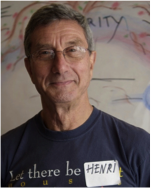 Photo of Henri by David Gasser
Photo of Henri by David Gasser
Our work developing Liberating Structures (LS)* has been full of surprise. Surprises that liberated our initial concepts and practices.
Early efforts began with influence from complexity science inspired scholars and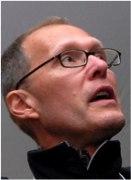 Photo of Keith by David Gasser leaders. A community with shared interests formed around the Plexus Institute. Henri and I wanted passionately to make complexity science insights practical in organizations.
Photo of Keith by David Gasser leaders. A community with shared interests formed around the Plexus Institute. Henri and I wanted passionately to make complexity science insights practical in organizations.
In 2001-2002, we began to test rough prototypes within healthcare. More serious field work started in business settings in Latin America in 2002 and 2003.
Liberating Structures have expanded in unexpected directions. Our initial hunches were tiny compared with what we have discovered.
Liberating Structures: Simple, Subtle, Powerful on Vimeo.
Hunch 1 In collaboration with leaders, we started with the purpose of helping frontline groups innovate. Our hunch: introduce simple methods to spark new habits and interaction patterns. The new patterns will, in turn, unleash the front line’s collective creativity.
Surprise 1: LS Transcend Conventional Boundaries
![]() While the frontline was definitely liberated and collectively creative, LS spread well beyond the frontline to many other domains. LS quickly moved out to other frontline groups and their customers, and up into leadership. There didn’t seem to be a challenge, big or small, where LS could not have influence. Professional, functional, and interpersonal boundaries came tumbling down.
While the frontline was definitely liberated and collectively creative, LS spread well beyond the frontline to many other domains. LS quickly moved out to other frontline groups and their customers, and up into leadership. There didn’t seem to be a challenge, big or small, where LS could not have influence. Professional, functional, and interpersonal boundaries came tumbling down.
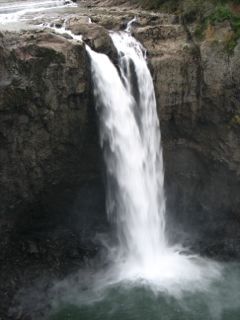 Liberating Structures were applied to what was important to each individual. A range of issues covered every aspect, function and level that can be found in organizations (frontline, senior teams, cross-functional issues, marketing, HR, research, finance, IT, manufacturing, people management, training, communication, teamwork, discrimination, etc.). Further, participants applied LS to their close relationships: leaders with followers, parents with children, even their relationship with themselves!
Liberating Structures were applied to what was important to each individual. A range of issues covered every aspect, function and level that can be found in organizations (frontline, senior teams, cross-functional issues, marketing, HR, research, finance, IT, manufacturing, people management, training, communication, teamwork, discrimination, etc.). Further, participants applied LS to their close relationships: leaders with followers, parents with children, even their relationship with themselves!
We were dumbfounded and delighted. In every case, together with clients, we found opportunities for one or more LS to contribute significantly.
Hunch 2 We believed that attracting (rather than compelling) lively participation would generate momentum for change and innovation. Our hunch: give everyone a choice of many innovative methods (without the pressure of a top-down “best practices” initiative) and pockets of innovation will flourish.
Surprise 2: Including & Unleashing Everyone Sparks A Powerful Movement
![]() Repeatedly in different countries and cultures, groups using Liberating Structures had emotionally uplifting experiences, more like a movement than a management strategy. LS seemed to fill a universal need not just for productive methods but also for ways of working together that are generative, seriously fun, and build trust. It seemed like a miracle. The relationship between the top-middle-frontline-and-customers started to shift with a small set of changes.
Repeatedly in different countries and cultures, groups using Liberating Structures had emotionally uplifting experiences, more like a movement than a management strategy. LS seemed to fill a universal need not just for productive methods but also for ways of working together that are generative, seriously fun, and build trust. It seemed like a miracle. The relationship between the top-middle-frontline-and-customers started to shift with a small set of changes.
At first the enthusiasm startled us. We couldn’t dare believe that it would happen again. Then, as the same pattern was repeated in a variety of cultures, we started making sense of what LS contributed to each local contextual change. It came to us from seeing how individuals and groups joyfully transformed their work. Now, for the first time, they knew how to include and unleash others around them. LS users could now act on what they valued and believed.
We saw how leaders shifted from traditional “command and control” principles and practices. To be fair we also saw how sometimes they struggled to withstand the tide of traditional practices. As their experience with LS grew their views about leadership evolved.
 The LS community continues to update the LS repertoire--including the invention of new LS--based on the diverse experience in the field. Pictured: Keith “listening” in Brussels.
The LS community continues to update the LS repertoire--including the invention of new LS--based on the diverse experience in the field. Pictured: Keith “listening” in Brussels.
Hunch 3 We believed that widely distributed challenges demanded widely distributed solutions. Everyone needs to change and contribute for broad, durable impact. Our hunch: including and unleashing large groups would increase the ownership of solutions.
Surprise 3: Social Proof Fuels Tangible Results
![]() Soon after LS immersion workshops were held, we started to hear outrageous stories from the field. Early adopters applied Liberating Structures, got great results, and were immediately copied by peers and customers. Frontline ownership of solutions improved dramatically.
Soon after LS immersion workshops were held, we started to hear outrageous stories from the field. Early adopters applied Liberating Structures, got great results, and were immediately copied by peers and customers. Frontline ownership of solutions improved dramatically.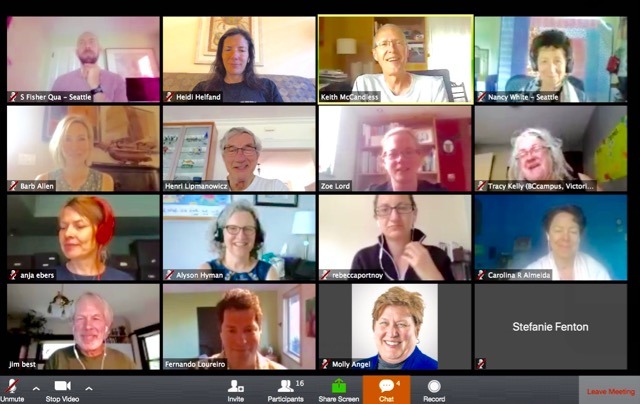 Zoom, Google docs, and Slack social networking platforms help connect far flung LS users.
Zoom, Google docs, and Slack social networking platforms help connect far flung LS users.
Early success hinted that impressive results were possible. In a Toronto hospital unit, a successful “movement” to prevent infections was sparked by one doctor who decided to change into surgical scrubs outside of operating rooms. She was not a surgeon but rather a person signaling her personal intention to stop spreading infections. Within months, their unit’s infection rate fell to zero.
In Peru, one day after an immersion workshop, participants completely redesigned their meeting with 200 top customers and achieved delightful results. In Venezuela, LS fueled dramatic business results in just one year. [read Business Turnaround: From Lagging to Leading] After one particularly engaging meeting, customers wanted to learn the methods they just experienced. When the word got out, competitors tried to copy LS use. Powerful social proof bubbled up well before conventional metrics were analyzed.
The methods spread person-to-person without any help from us. While we offered one-on-one coaching immediately following workshops, most of the success was initiated by emerging leaders and people that were typically excluded from innovation efforts. (We call them unusual suspects). Again, this pattern dumbfounded and delighted us. LS novices could quickly generate and sustain tangible results. No waiting for conventional or scientific proof. Social proof fueled tangible evidence in short order.
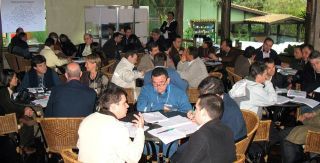
Pictured right: our first Liberating Structures immersion workshop was held in Brazil, over a koi pond in a piano bar.
* The term Liberating Structures was first introduced by William Torbert a professor at Boston College. He explored the notion of forms of organization structure that gave guidance to people in a way that they developed skills to guide themselves. He advanced a theory of power that generates productivity, justice and inquiry; and a theory of 'liberating structure' through which organizations can generate continual quality improvement. (contributed by Lisa Kimball)

Liberating Structures are inspired and informed by complexity science--the science of emergence. This entertaining Radiolab program explores how order in nature emerges without central control. It starts with how lightning bugs synchronize their flashing. "What happens when there is no leader? Starlings, bees, and ants manage just fine. In fact, they form staggeringly complicated societies -- all without a Toscanini to conduct them into harmony. This hour of Radiolab, we ask how this happens."
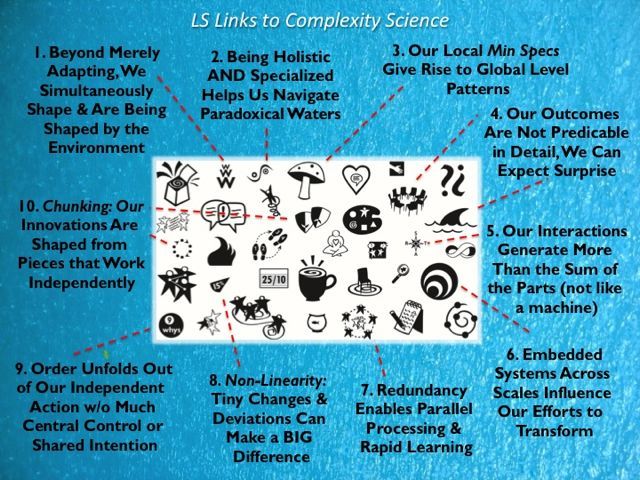 Inspiration for Liberating Structures started with insights from complexity science
Inspiration for Liberating Structures started with insights from complexity science

The eye sees only what the mind is prepared to comprehend. Henri Bergson
